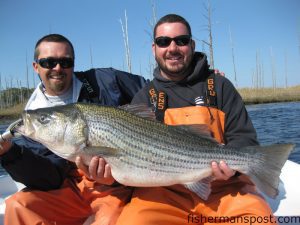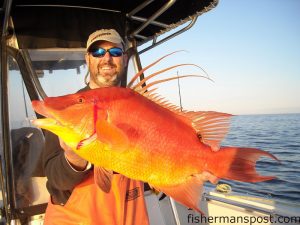Wrightsville Beach March 12, 2009

Capt. Jamie Rushing, of Seagate Charters, and Capt. Blair White with a 37.5", 26 lb. striped bass White hooked in the NE Cape Fear River on a deep diving crankbait.
Arlen, of Tex’s Tackle, reports that inshore anglers are finding some drum feeding around deeper docks and in the channels near the inlets. Live mud minnows, cut baits, and soft plastics worked very slowly are producing the best action with the reds.
There are also some large schools of reds cruising the surf line along the beaches between Topsail and Wrightsville. Anglers can cast to the schools from the beach when they can find them, or wait for a calm day and go hunting from a boat on the backside of the breakers. Gulp baits are good choices for the surf reds.
A few spike speckled trout are biting right now in the deeper basins and around docks. As the water temperature rises over the next few weeks, the trout action should improve and anglers will also begin to see some larger fish.
Offshore, the bottom fishing has been spotty at best within 30 miles of the beach due to the cold water and huge numbers of dog sharks. There are a few gags holding at structure around 20 miles off, but fighting the sharks to get to them can grow tiresome.
Bottom fishermen are putting together some good catches of sea bass at structure 30-35 miles out, and finding some fat red grouper in the 45-50 mile range. Both bait and jigs are producing on the grouper and bass.
As the water temperature rises, the grouper bite in the 35-40 mile range should improve dramatically.
Offshore jigging 55-60 miles off the beaches produced some serious results last week, with anglers landing big numbers of cobia, huge amberjacks, bruiser gag grouper (up to 40 lbs.), African pompano, and other species.
Gulf Stream trollers found good action with wahoo (some bigger fish up to 60 lbs.), blackfin tunas, and smaller gaffer dolphin last week as well. A few yellowfin tuna were caught at the Swansboro Hole to boot, so the spring blue water action is getting into gear. Interestingly, the best blue water fishing lately has been in water much cooler than normal (mid-upper 60’s) in around 30-50 fathoms.
The cool water has moved the king mackerel well offshore, too, and boats reported big numbers of kings around the Big Rock and Swansboro Hole last week.

Capt. Jot Owens with a fat speckled trout that fell for a good penny colored Blurp shrimp near Masonboro Inlet.
Jon, of Intracoastal Angler, reports that anglers are finding some king mackerel and blackfin tuna starting around 40 miles offshore.
Bottom fishing has been decent, but not on fire, in the same areas.
Out at the edge of the Gulf Stream, boats are finding blackfin tuna, some wahoo, and a few yellowfins already. Both trolling with skirted ballyhoo and working vertical jigs around bait and fish marks have been producing results on the tuna and wahoo.
Inshore, there are some speckled trout and red drum around, but the water’s still pretty cold for consistent catches. Deeper holes are holding most of the specks, with the reds mixed between deeper areas and the flats. Gulp baits and other soft plastics worked very slowly are the ticket to bites from these fish in the cold water.
As the water warms up over the coming weeks, the specks and reds should become more active, and the topwater bite should get fired up sometime around the beginning of April.

Nick Maraveyias, of Wilmington, with a hogfish he hooked on a jig 40 miles offshore of Carolina Beach in late February. He was fishing with Nick Patsalos about the "Slip Slidin."
Rick, of Living Waters Guide Service, reports that the offshore fishing has been solid when the weather lets boats make the long run. Good numbers of blackfin tuna (some studs to 35 lbs.) are holding around the edge of the Stream, and vertical jigging has been outproducing trolling for them lately.
Trollers have been coming up with a few blackfins along with some wahoo and gaffer dolphin. Swimming plugs and skirted ballyhoo are the trolling baits of choice.
Vertical jigging over bottom structure in the 150-200′ range lately has been producing action with a wide variety of fish including good numbers of cobia (up to 60 lbs.), all the big amberjacks anglers can handle, gag grouper (20-40 lbs.), scamp grouper, African pompano, hogfish, and other species. The Blue Water Candy Roscoe jig has been the most productive lure.
Jim, of Plan 9 Charters, reports that there are schools of red drum cruising the beaches up to the north. Anglers can run the beaches in the boat looking for them on calm days, and hook up while casting Mirrolures or a variety of soft plastics.
Inshore, there are few drum around, but the bite will get better as the water warms up in the coming weeks. Anglers will also begin to see some bluefish feeding inshore, and the trout bite will improve as well.
Whiting are schooling up near the mouth of the Cape Fear River, and anglers can have fun hooking them on simple two-hook bottom rigs baited with shrimp.
Offshore, there’s a decent sea bass bite from 20 miles on out, but little other than sharks in closer.
Once the water temperature (which is now in the low-50’s) hits 60 degrees, anglers can begin looking for Atlantic bonito around nearshore structure like the Liberty Ship and 5 Mile Boxcars.
Danny, of 96 Charter Company, reports that the striped bass bite continues to be good in the Cape Fear River. Anglers are hooking the stripers while casting crankbaits and swimbaits around creek mouths and channel edges in the river. Some bruisers (over 25 lbs.) have been caught already this spring, so anglers should be prepared for the possibility of hooking a monster.
Rob, of Johnnie Mercer’s Pier, reports that anglers have mostly been catching sharks lately, especially at night.
However, they’re seeing whiting and red drum from the pier, and the water just needs to warm up a little bit to make them bite. Shrimp and cut baits will tempt bites from these bottom feeders.
The water is 52 degrees now, and it should only take another warm day or two to get the fish feeding.
